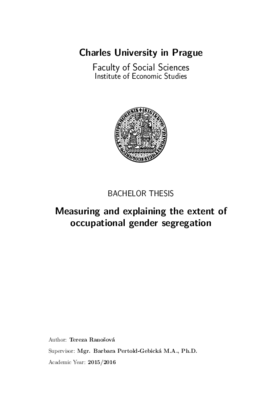Measuring and explaining the extent of occupational gender segregation
Genderová segregace na trhu práce - rozsah a příčiny
bakalářská práce (OBHÁJENO)

Zobrazit/
Trvalý odkaz
http://hdl.handle.net/20.500.11956/78182Identifikátory
SIS: 162877
Katalog UK: 990020929650106986
Kolekce
- Kvalifikační práce [19618]
Autor
Vedoucí práce
Oponent práce
Žigraiová, Diana
Fakulta / součást
Fakulta sociálních věd
Obor
Ekonomie a finance
Katedra / ústav / klinika
Institut ekonomických studií
Datum obhajoby
15. 6. 2016
Nakladatel
Univerzita Karlova, Fakulta sociálních vědJazyk
Angličtina
Známka
Výborně
Klíčová slova (česky)
genderová segregace, zaměstnání, charakteristiky zaměstnání, Česká republikaKlíčová slova (anglicky)
gender segregation, occupation, job characteristics, Czech RepublicGenderová segregace v zaměstnání je jednou z nejviditelnějších charakteristik trhu práce po celém světě, Česká republika není výjimkou. V roce 2013 by více než 57% všech žen nebo všech mužů muselo změnit práci, aby mohl být poměr obou pohlaví stejný v každém zaměstnání. Pokud přidáme péči o děti a práci v domácnosti mezi ostatní povolání, muselo by se přemístit více než 60% žen nebo mužů. V porovnání s ženami jsou navíc muži na trhu práce více izolováni - 18% z nich pracuje v zaměstnání s méně než jedním procentem žen. Proti všem očekáváním jsou navíc nejmladší kohorty vystaveny silnější segregaci než generace dnešních třicátníků a čtyřicátníků. V druhé polovině práce jsou zaměstnání charakterizována podle toho, jaké vyžadují schopnosti a způsoby, v jakém se odehrávají kontextu, či jaké jsou jejich zájmy a hodnoty (s využitím databáze O*NET). Celkem 18 z těchto charakteristik prokázalo statisticky významný efekt na výsledný poměr mužů a žen v jednotlivých zaměstnáních. Nejpřekvapivějším výsledkem je fakt, že vyšší nároky na matematické uvažování zvyšují koncentraci žen, zatímco schopnost zapamatovat si větší množství informací zdá se straní mužům. Powered by TCPDF (www.tcpdf.org)
Occupational gender segregation is one of the most visible characteristics of labour markets all over the world, the Czech Republic is not an exception. In 2013 more than 57% of employed men or women would have to change their job so that the proportion of each gender could be the same in each occupation. The measure increases to 60.19% when housework is treated as another occupation. Moreover, men are often almost completely isolated from women - more than 18% of them work in an occupation with less than one percent of female colleagues. Unexpectedly, the youngest cohorts in the sample experience higher segregation than men and women in their thirties and forties. In the second half of the thesis occupations are characterised by their demanded abilities and work styles, contexts, values and interests (utilizing the O*NET database). It is tested which of these characteristics actually matter for the concentration of men or women in an occupation. Altogether, eighteen characteristics proved significant. The most surprising result is that higher demanded levels of mathematics and memorization attract the opposite gender than is assumed in the literature. Powered by TCPDF (www.tcpdf.org)
